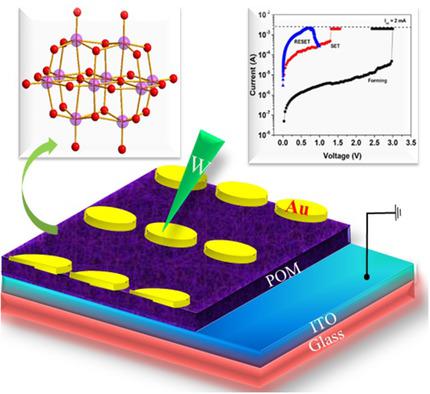当前位置:
X-MOL 学术
›
Phys. Status Solidi A
›
论文详情
Our official English website, www.x-mol.net, welcomes your feedback! (Note: you will need to create a separate account there.)
Redox‐Active Vanadium‐Based Polyoxometalate as an Active Element in Resistive Switching Based Nonvolatile Molecular Memory
Physica Status Solidi (A) - Applications and Materials Science ( IF 2 ) Pub Date : 2020-07-25 , DOI: 10.1002/pssa.202000306 Sterin N. S. 1 , Nivedita Basu 2 , Marc Cahay 3 , Satyanarayan M. N. 4 , Sib Sankar Mal 5 , Partha Pratim Das 1
Physica Status Solidi (A) - Applications and Materials Science ( IF 2 ) Pub Date : 2020-07-25 , DOI: 10.1002/pssa.202000306 Sterin N. S. 1 , Nivedita Basu 2 , Marc Cahay 3 , Satyanarayan M. N. 4 , Sib Sankar Mal 5 , Partha Pratim Das 1
Affiliation

|
Resistive switching (RS)‐based random access memory has been envisaged as a viable alternative to existing memory technology due to its nonvolatility, high switching speed, high endurance/retention, and considerably low operating voltage. Herein, a new uniform, repetitive, and stable RS phenomenon is demonstrated based on very low‐cost two‐terminal metal–insulator–metal stack fabricated using a highly redox‐active vanadium‐based polyoxometalate (POM) molecular clusters, [V10O28]6−—belonging to polyoxovanadate (POV) family. The RS is observed to be unipolar and nonvolatile in nature, and occur at a fairly low operating bias voltage (less than 2 V), making it suitable for low‐power operations. The switching event is attributed to the cycling between formation and rupture of tiny conductive nanofilaments formed due to trapping and detrapping of positively charged ionized oxygen vacancy sites present in the active switching layer of [V10O28]6−. POMs, in their rich abundance, are highly stable early transition‐metal oxide nanosized clusters, capable of storing as well as releasing a large number of electrons. In addition, they can undergo fast and reversible redox reactions (both in solid and liquid electrolyte media) in “stepwise” manner—a property that makes them a promising candidate for ultrafast and multi‐level nonvolatile molecular memory for high‐density data storage. Preliminary investigations on the POV‐based memory cells result in device resistance ratio ≈25, endurance for more than 200 cycles, and stable retention time around 2200 s, in fully open air condition.
中文翻译:

氧化还原活性钒基多金属氧酸盐作为基于电阻开关的非易失性分子存储器中的活性元素
基于电阻切换(RS)的随机存取存储器由于其非易失性,高切换速度,高耐久性/保持力以及相当低的工作电压而被认为是现有存储技术的可行替代方案。在此,基于使用具有高氧化还原活性的钒基多金属氧酸盐(POM)分子簇[V 10 O]制造的非常廉价的两端子金属-绝缘体-金属叠层,证明了一种新的均匀,重复且稳定的RS现象。28 ] 6−—属于聚氧钒酸盐(POV)家族。观察到RS本质上是单极性和非易失性的,并且发生在相当低的工作偏置电压(小于2 V)时,使其适用于低功率工作。开关事件归因于由于[V 10 O 28 ] 6−的有源开关层中存在的带正电的离子化氧空位的俘获和释放而形成的微小导电纳米丝的形成与断裂之间的循环。。POM数量丰富,是高度稳定的早期过渡金属氧化物纳米尺寸的簇,能够存储和释放大量电子。此外,它们可以“逐步”方式进行快速和可逆的氧化还原反应(在固体和液体电解质介质中),这一特性使其成为用于高密度数据存储的超快和多层非易失性分子存储器的有希望的候选者。在基于POV的存储单元上进行的初步研究得出,在完全开放的空气条件下,器件的电阻比约为25,耐用性超过200个周期,并且保持时间稳定在2200 s左右。
更新日期:2020-09-21
中文翻译:

氧化还原活性钒基多金属氧酸盐作为基于电阻开关的非易失性分子存储器中的活性元素
基于电阻切换(RS)的随机存取存储器由于其非易失性,高切换速度,高耐久性/保持力以及相当低的工作电压而被认为是现有存储技术的可行替代方案。在此,基于使用具有高氧化还原活性的钒基多金属氧酸盐(POM)分子簇[V 10 O]制造的非常廉价的两端子金属-绝缘体-金属叠层,证明了一种新的均匀,重复且稳定的RS现象。28 ] 6−—属于聚氧钒酸盐(POV)家族。观察到RS本质上是单极性和非易失性的,并且发生在相当低的工作偏置电压(小于2 V)时,使其适用于低功率工作。开关事件归因于由于[V 10 O 28 ] 6−的有源开关层中存在的带正电的离子化氧空位的俘获和释放而形成的微小导电纳米丝的形成与断裂之间的循环。。POM数量丰富,是高度稳定的早期过渡金属氧化物纳米尺寸的簇,能够存储和释放大量电子。此外,它们可以“逐步”方式进行快速和可逆的氧化还原反应(在固体和液体电解质介质中),这一特性使其成为用于高密度数据存储的超快和多层非易失性分子存储器的有希望的候选者。在基于POV的存储单元上进行的初步研究得出,在完全开放的空气条件下,器件的电阻比约为25,耐用性超过200个周期,并且保持时间稳定在2200 s左右。


























 京公网安备 11010802027423号
京公网安备 11010802027423号